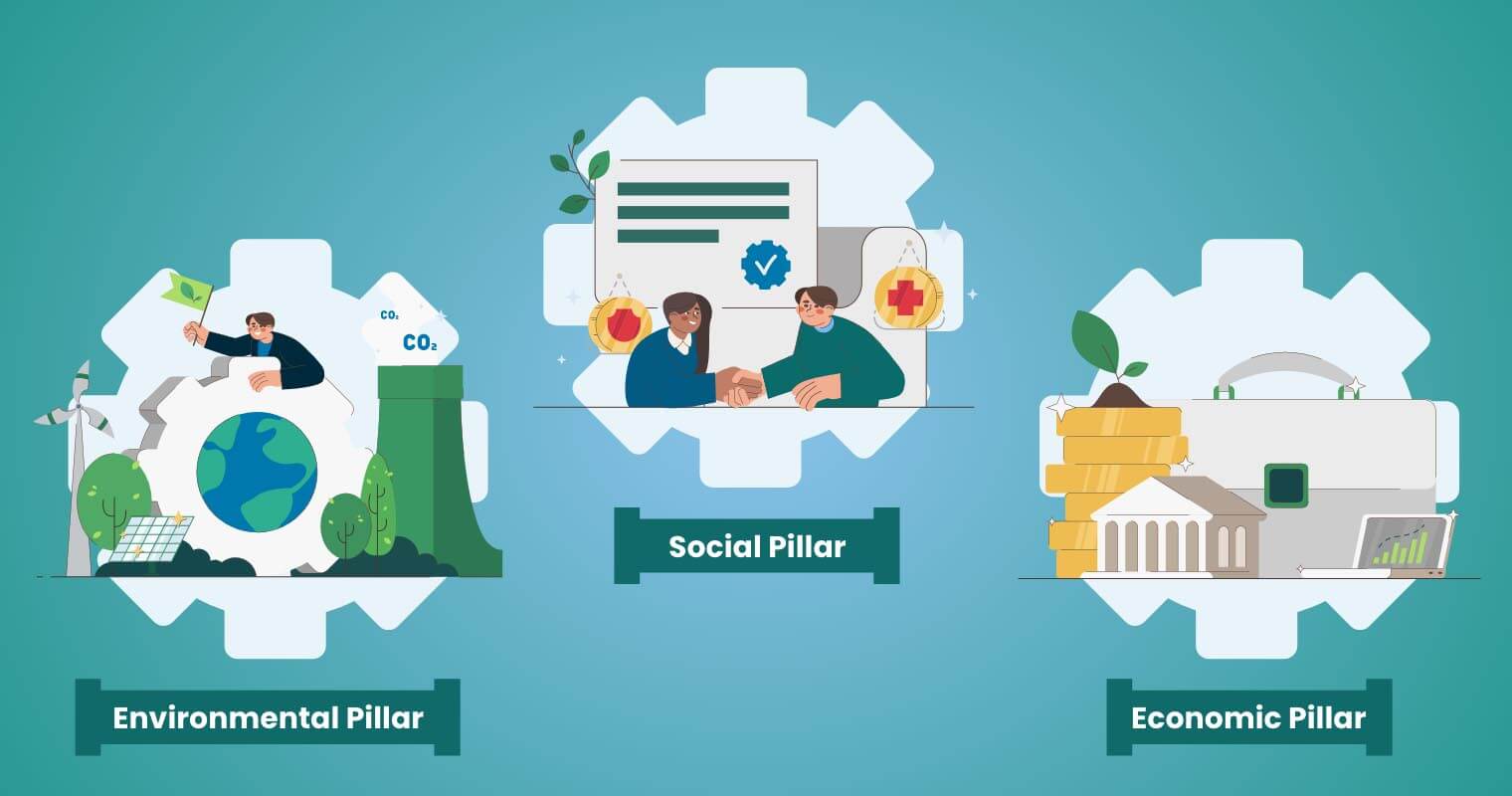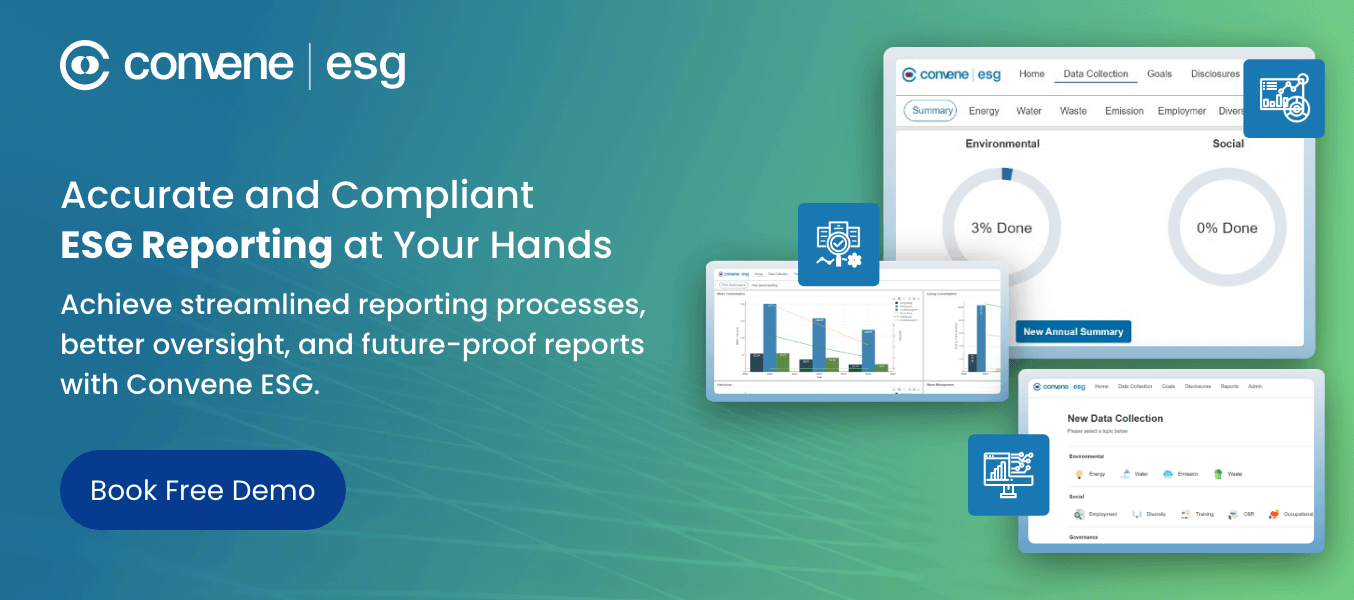Sustainability isn’t just about being ethical—it’s smart business.
Focusing on sustainability in businesses is presumed to lead to a 10% revenue increase compared to peers. These companies, prioritising sustainable practices, are twice as likely to achieve this growth.
Given this fact, it’s safe to say that in an era where climate change and environmental concerns are at the forefront of discussions, businesses that embrace sustainability are setting themselves up for resiliency and success.
What is corporate sustainability?
Corporate sustainability is a holistic approach to conducting business that involves making decisions benefiting both the company and the planet. The goal is to create ways to meet present needs while building a greener future by integrating environmental, social, and governance (ESG) factors into current business practices. Some initiatives may include:
- Reducing and monitoring carbon emissions and energy consumption
- Minimising waste and promoting sustainable practices
- Investing in renewable energy
- Developing marketing campaigns that highlight green initiatives
- Sharing best practices and collaborating with other organisations for larger sustainability programs
Corporate Sustainability vs. Corporate Social Responsibility
Although both terms seem similar and aim for a positive impact, they each have a distinct purpose. Corporate responsibility focuses on achieving business goals environmentally and ethically. In contrast, corporate social responsibility (CSR) is a broader social and ethical concept in which a company voluntarily acts on issues beyond profit.
CSR typically refers to specific initiatives or programs undertaken by a company to address social and environmental issues in its community, such as:
- Charitable donations to support a cause
- Community involvement
- Volunteer programs
- Environmental conservation efforts
The major difference between the two is that even though CSR contributes to sustainability, it may not always directly impact a company’s long-term profitability.
What are the three pillars of sustainability?
To create lasting value, companies must learn to balance the three Ps of corporate sustainability: the planet, or environmental pillar; people, or social pillar; and profit, or economic pillar. Together, the three pillars work in harmony to attain true sustainability.

Environmental Pillar
Environmental sustainability addresses actions that reduce a company’s ecological footprint, which more and more businesses are putting way up on their priority list. Some of the things that help strengthen this pillar include:
Reducing packaging waste by promoting reusable materials.
Implementing water-saving practices to protect the resource.
Transitioning to clean energy sources, like solar and wind energy, to help mitigate climate change.
Social Pillar
The social pillar focuses on people—both within and outside the organisation. It emphasises awareness of the impact of business operations and products on employees, customers, and the community it serves.
To generate social sustainability through its employees, a company should prioritise retention, fairness, and well-being through fair wages and safe working conditions. For customers, the company must be able and willing to cater to their clients’ demands. Lastly, they must look into fundraising, sponsorship, and local investments to keep community engagement high.
Economic Pillar
Companies need to invest in innovative technologies and processes that improve efficiency and reduce costs to be profitable and drive growth. But being sustainable is another thing.
The economic pillar merges sustainability with financial viability. It acknowledges that while economic growth is necessary to improve living standards, it must be achieved in a way that does not compromise the environment. Therefore, sustainable practices must closely align with economic goals.
Another factor is managing partnerships with stakeholders and allocating resources in a way that aligns with their values and interests. This builds mutual trust, ultimately leading to more equitable outcomes.
In light of this, companies are urged to give equal importance to issues affecting both the financial and environmental aspects of their business operations. Double materiality, as mandated by the Corporate Sustainability Reporting Directive (CSRD), is one of the practices that can be done by organisations that requires them to conduct a comprehensive assessment from two perspectives: environmental materiality and financial materiality. This new approach is vital for strategic decision-making and alignment with stakeholders.
Read: Double Materiality: New Approach to Corporate Sustainability
Benefits of Corporate Sustainability to Organisations
More than the alleviated environmental effects of pushing for sustainability, companies can also benefit from the following:
1. Long-term profitability
When businesses integrate sustainability practices into their operations, they experience better financial performance in the long run. This is because ESG metrics guide investors toward ethically sound choices. Correspondingly, companies with sustainability at their core tend to attract more investors.
Another reason for this is that sustainable practices often lead to cost savings. For instance, energy-efficient processes reduce operational expenses while increasing financial results. Moreover, sustainable companies enhance customer loyalty. As previously mentioned, consumers prefer products and services from sustainable brands because they have become more environmentally conscious. Meeting this demand translates to increased sales and revenue.
2. Enhanced brand reputation
A positive reputation is a valuable asset for any business. When customers trust a brand, they are more likely to make repeat purchases and recommend it to others because they feel it contributes to positive social and environmental change. A 2022 study by NielsenIQ showed that 78% of consumers lean toward a sustainable lifestyle, indicating a growing awareness and preference for environmentally responsible brands.
Ultimately, a strong reputation differentiates a brand from its competitors and enhances its resilience and longevity in the market.
3. Improved risk management and resilience
Sustainable practices ease many risks stemming from climate change and regulatory changes.
Companies that can adapt to climate-change-induced risks, such as hurricanes or sea level rise, are typically well-placed because they invest in infrastructure and build contingency plans, thereby safeguarding their operations, assets, and reputation against unpredictable environmental challenges.
These companies also have better risk management in handling ever-evolving regulations, like the ISSB sustainability disclosure standards, because they proactively align their mission and vision with industry standards. In turn, companies mitigate legal and reputational risks and remain resilient, ensuring continuity even during crises.
4. Reduced environmental impact
Businesses committed to reducing their environmental impact actively work toward one goal: creating strategies that reduce waste, conserve resources, and embrace renewable energy sources. By adopting sustainable practices in everyday operations, such as chemical management and using eco-friendly materials, they can positively contribute to environmental preservation. More importantly, it can lead to cost savings through improved resource efficiency and optimised operations.
Corporate Sustainability Examples in Action
With sustainability at its core, many companies are already making an impact through their innovative products and solutions. Here are two of the organisations that are leading the charge in this movement:
Microsoft
Microsoft is a multinational technology company known for providing a wide range of software products. In talks of sustainability, they have made waves by creating a corporate sustainability strategy to weave their technology into solutions that address environmental challenges.
In 2022, they have invested in carbon removal, acquiring 1.4 million tons from various sources and recycling it into marketable products. By 2030, their goal is to be carbon negative, water positive, and produce zero waste. They have also announced their plans to build a planetary computer utilising global data and artificial intelligence to provide sustainable insights.
Walmart
As one of the largest retail corporations in the world, Walmart has a big role to play in promoting corporate sustainability, and it lives up to those expectations. For over 15 years, Walmart has been working to help the people and the planet by sourcing responsibly and selling sustainable products. In fact, they launched a shopping application, Built for Better, in 2021 to help customers shop with purpose. The goal is to help users identify and shop for products that meet independent and authoritative standards for promoting personal well-being and reducing carbon footprint.
Today, Walmart has set new corporate sustainability goals that it aims to accomplish by 2025. This includes:
- Cutting down their use of new plastic by 15% compared to 2020;
- Boosting purchases of eco-friendly products by 15%;
- And slashing landfill waste by 25% by working with recycling partners.
Strategies for Corporate Sustainability

Achieving sustainability in the corporate world is a lot of work. However, the benefits far outweigh the efforts invested. If you’re looking to develop your plan, here are some strategies you can consider and then modify in whichever way suits your business:
- Stakeholder Engagement – In your efforts to be sustainable, always involve your employees, customers, and the community because they are the ones who will keep the business running. One useful corporate sustainability strategy is encouraging employees to participate in energy conservation and waste reduction efforts. Externally, aside from offering green products and solutions, make it a priority to ask consumers for feedback regarding their preferences and concerns.
- Collaborations and Partnerships – Once you have your people involved, reach out and join forces with partners and suppliers that can help create a sustainable supply chain, from sourcing raw materials to logistics.
- Innovation and Technology Adoption – Leveraging cutting-edge solutions will help your business keep up. These solutions often include utilising renewable energy sources, implementing circular economy practices, and using data analytics to optimise energy usage.
- Impact Assessment and Clear Goals (ESG Reporting) – Measure progress transparently by conducting thorough ESG assessments to learn how they impact your business. Make sure to establish specific, measurable goals for accurate metrics evaluation. Integrating modern ESG reporting software may be beneficial if you want to simplify this process.
- Sustainability Training – Sustainability is not a one-man job and does not happen overnight. Ensure everyone in the organisation can keep up with sustainability trends and are well-informed of the corporate sustainability goals and principles you are trying to instill. This requires providing comprehensive training programs, workshops, and online courses on topics, such as energy conservation, sustainable procurement, and bad practices like greenwashing and greenhushing.
Frequently Asked Questions
What role do consumers play in driving sustainability?
As consumers increasingly prioritise eco-friendly products and ethical business practices before making a purchase, market demand is reshaping. In response, companies are compelled to adopt sustainable practices to meet consumer expectations.
Is corporate sustainability only relevant for large corporations?
No, corporate sustainability is relevant for businesses of all sizes. While large corporations may have more resources to implement corporate sustainability initiatives on a larger scale, small and medium enterprises (SMEs) can make meaningful contributions to sustainability through initiatives such as reducing waste, improving energy efficiency, and adopting environmentally friendly practices.
What role does government regulation play in corporate sustainability?
Government regulations create a framework encouraging companies to integrate sustainability into their operations. These regulations set standards for environmental protection, labor practices, and ethical business conduct.
Boost Corporate Sustainability Reporting with Convene ESG
Championing corporate sustainability ends not with implementing eco-friendly practices within the organisation. It extends to transparently disclosing these efforts and their impact on the organisation and the public. Corporate sustainability reporting has become imperative worldwide, driving companies to look into ways to help them navigate its complexities. In such times, ESG software like Convene ESG emerges as a powerful ally.
With its comprehensive suite of tools and services, Convene ESG empowers companies to effectively assess, manage, and improve their ESG performance. This centralised ESG reporting software helps organisations streamline their process from consolidation to documentation using pre-built templates that follow global ESG disclosure standards, such as GRI, CSRD, TCFD, and ISSB.
Explore other features of Convene ESG that can help boost your corporate sustainability reporting by scheduling a demo today.

Jess is a Content Marketing Writer at Convene who commits herself to creating relevant, easy-to-digest, and SEO-friendly content. Before writing articles on governance and board management, she worked as a creative copywriter for a paint company, where she developed a keen eye for detail and a passion for making complex information accessible and enjoyable for readers. In her free time, she’s absorbed in the most random things. Her recent obsession is watching gardening videos for hours and dreaming of someday having her own kitchen garden.















